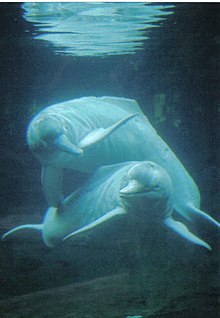Amazon river dolphin: Difference between revisions
Crazydaisy96 (talk | contribs) |
m Reverted edits by Crazydaisy96 to last version by Someguy1221 (HG) |
||
| Line 44: | Line 44: | ||
Some older classifications listed the ''boliviensis'' population as a separate species. |
Some older classifications listed the ''boliviensis'' population as a separate species. |
||
During the rainy seasons, the forest is flooded with the river's water. Boto dolphins and fish are known to swim in between the trees! However they are easier to be spotted during the dry season. |
|||
These dolphins, more active near dawn and dusk, range in color from gray to pink. Several factors make a boto dolphin more pink then gray. As they age, they can become more pink. Also, they are pinker in darker waters. They sort of get a "suntan" in clear waters and turn gray. They can get pinker when excited, like humans blushing. |
|||
==Mythology== |
==Mythology== |
||
Revision as of 19:25, 22 July 2008
- "Inia" redirects here; for the town in Cyprus, see Inia, Cyprus.
| Boto | |
|---|---|

| |
| A Boto at Duisburg Zoo. | |

| |
| Size comparison against an average human | |
| Scientific classification | |
| Kingdom: | |
| Phylum: | |
| Class: | |
| Subclass: | |
| Order: | |
| Suborder: | |
| Superfamily: | |
| Family: | Iniidae Gray, 1846
|
| Genus: | Inia
|
| Species: | I. geoffrensis
|
| Binomial name | |
| Inia geoffrensis Blainville, 1817
| |

| |
| Boto range | |
The Nay, Boutu, Amazon River Dolphin or Pink River Dolphin[1] (Inia geoffrensis) is a freshwater river dolphin endemic to the Amazon River and Orinoco River systems. The largest of the river dolphins, this species is not to be confused with the Tucuxi (Sotalia fluviatilis), whose range overlaps that of the Boto but is not a true river dolphin.
The IUCN lists various other names to describe this species including Amazon Dolphin, Boto Vermelho, Boto Cor-de-Rosa, Bouto, Bufeo, Dauphin de l'Amazone, Inia, Pink Dolphin, Wee Quacker, Pink Freshwater Dolphin, Pink Porpoise, and Tonina.
Taxonomy
The first type specimen was described by Henri Marie Ducrotay de Blainville in 1817.
1998 classification lists a single species, I. geoffrensis, in the genus Inia, with three recognised subspecies:
- I.g. geoffrensis - Amazon basin population (excluding Madeira river drainage area, above the Teotonio Rapids in Bolivia)
- I.g. boliviensis - Amazon basin population in the Madeira drainage area
- I.g. humboldtiana - Orinoco basin population
Some older classifications listed the boliviensis population as a separate species.
Mythology
In a traditional Amazon River myth, at night a Boto becomes a handsome young man who seduces girls,[2] impregnates them, then returns to the river in the morning to become a Boto again. This dolphin shapeshifter is called an encantado. It has been suggested that the myth arose partly because dolphin genitalia bear a resemblance to that of humans. In the local area, there are also tales that it is bad luck to kill a Boto. Legend also states that if a person makes eye contact with a Boto, that person will have nightmares for the rest of his or her life.

The 1987 Brazilian film [Ele, o Boto] is a supernatural romance featuring a boto who has a son by a young woman.
Food and diet
The Boto has 25-30 peg-like front teeth for catching prey and it mainly eats crustaceans, crabs, turtles, and catfish.
References
- ^ "Wildfacts: Boto". BBC. Retrieved 2007-02-21.
- ^ "Whales and Dolphins" at ancientspiral.com
- General references
- Template:IUCN2006 Database entry includes a lengthy justification of why this species is vulnerable.
- Rice, Dale W. (1998). Marine mammals of the world: systematics and distribution. Society of Marine Mammalogy Special Publication Number 4. 231 pp.
- Montgomery, Sy (2000). Journey of the pink dolphins : an Amazon quest. Simon & Schuster, 317 pages. 068484558X
- Juliet Clutton-Brock (2000). Mammals, 381 pages.
- Hilda. "Pink Dolphin". Retrieved 2007-09-08.
External links
- Book: "Pink dolphin, friend of the river" (Web Site - English & Spanish)
- Omacha Foundation - A non-government and non-profit organisation, created to study, research and protect river dolphins and other fauna and aquatic ecosystems in Colombia (website in English and Spanish). Winner of the 2007 Whitley Awards (UK)
- Projeto Boto - a non-profit research project that is increasing knowledge, understanding and the conservation prospects of the Amazon's two endemic dolphins - the boto (Inia geoffrensis) and the tucuxi (Sotalia fluviatilis)
- Dolphins, Whales and Porpoises: 2002–2010 Conservation Action Plan for the World's Cetaceans. IUCN/SSC Cetacean Specialist Group 2003, Reeves et al. HTML copy of book-length report
- Convention on Migratory Species page on the Amazon Dolphin
- The Nature Conservancy works to protect habitat for the Boto
- Walker's Mammals of the World Online - Amazon Dolphins
- Animal Info page on the Boto
- - Virtual Explorers
- Whale & Dolphin Conservation Society (WDCS)
- [1]
- - The Motorcyle Diaries Script

